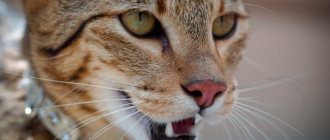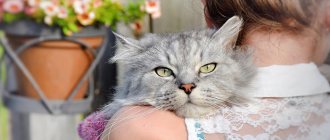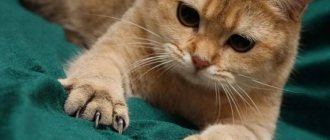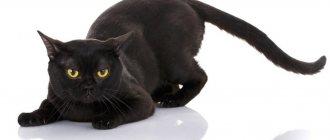Brief history of the breed
This breed originated in Great Britain in 1981. Her story began with an accidental mating of a Burmese cat of the English Baroness Miranda von Kirchberg and a luxurious chinchilla-colored Persian.
After the news of what happened, the hostess could not come to her senses for a long time. But after the appearance of the most beautiful kittens, the baroness decided to start breeding a new breed called Burmilla. Soon the result of her work aroused the interest of local nursery owners. Thanks to joint efforts, in 1990 the Burmilla was awarded champion status.
Diseases
Burmilla's health is quite good. Timely vaccinations will help avoid serious diseases in the future. Many cat owners think that if their pet does not leave the house, then they do not need vaccination. However, it is not. Germs can appear at home and through dirty shoes, and the animal will get sick without direct contact with the infection.
The first vaccinations for Burmilla kittens are given at the age of 3 months, after performing anthelmintic procedures.
These animals suffer from diseases inherited from chinchilla cats and from Burmese cats.
These diseases include polycystic kidney disease. Your cat is urinating frequently. The disease can cause kidney failure in the animal. They do not have other genetic diseases.
They are prone to obesity; poor quality food can cause problems with the blood vessels of the heart.
Breed description, standards, appearance
The Burmese Silver is an elegant, proportionally built cat with graceful movements and well-developed muscles. A detailed description of the breed is presented in the official standard.
Dimensions and weight
Burmillas are medium-sized cats, they grow up to 25-30 cm at the withers. Sexual dimorphism is weakly expressed in the breed, so the weight of females and males is almost the same. The average weight of an adult Silver Burmese ranges from 4-6 kg.
Anatomical characteristics
A typical Burmilla cat should fit the following description:
- The head is medium-sized, rounded, smoothly contoured, with a short, wide muzzle and pronounced cheeks.
- The nose is small, with a pink nose.
- The eyes are large, expressive, widely set, with a black rim and an oriental cut. The shape resembles a crescent. The Burmilla's iris can be green or amber. Juvenile Burmese silvers are allowed to have bright orange eyes.
- The ears are medium in size, set wide apart, with a slight tilt forward.
- The body is strong, proportionally built, with developed muscles, a small woolly hump on the nape and a long, smoothly tapering tail.
- The limbs are spindle-shaped, muscular, with round paws and black pads. The hind legs of the Silver Burmese are longer than the front ones.
Color and coat type
Depending on the length of the guard hair, there are 2 varieties in the breed:
- Burmilla shorthair;
- longhaired burmilla.
The former have airy, fluffy fur, which gives them a resemblance to Persians. They were registered 10 years later than the shorthaired representatives of the breed and are better known as the Australian Tiffany.
Although Burmilla coat colors are very diverse, they are all very similar to each other. The main color of the fur is silver-white, and on the sides, head and back of the cat there is chocolate, blue, cream, red, lilac or caramel color.
Important! The Burmilla's belly, neck and chest are always white, and the tail, paws and muzzle are silvery. On the cat's forehead there is a pattern in the shape of the letter M.
Possible breed defects
According to the generally accepted standard, the following are considered exterior flaws:
- striped points on the paws;
- excessively long limbs;
- short body;
- a long nose;
- poorly developed chin;
- hump on the bridge of the nose;
- shaggy or elongated hair in short-haired individuals.
Burma owner reviews are negative
I decided to create a topic dedicated to this amazing breed. A few months ago I became the happy owner of 2 wonderful European Burmese cats. Just recently we got our third Burmka, and I’m sure it won’t be the last, because... there can never be too many burms
I wanted to open the topic for a long time, but after yesterday’s exhibition (“Meow Club”, Grad), I decided not to put it off. Don’t put it off because our Voronezh people, as it turns out, are not at all familiar with this breed, which is rare for us, but very common in Europe. Visitors to the exhibition, stopping near the cage with my cat, exclaimed: “Oh, little black one, Black cat, Black British, What is this, Mink? etc. etc.))) Some asked the name of the breed, but everyone, as one, asked again. This suggests that in Voronezh people have not even heard of such a breed. Yes, I myself, to be honest, found out about it 7-8 months ago)). As soon as I found out, I immediately wanted it.)) A couple of weeks ago we were at an exhibition in Minsk, so people there know not only the breed, but also the name of the color. But there are a lot of Burmese there. From all this it follows that it’s time for this amazing (for me, the best) breed to take a place in the sun in our city!
Article on the topic: Reviews from Opel Astra N owners
Burma - for those who possess it, this word sounds like a witchcraft spell, like a verse, like a sweet song. I could talk about this cat for hours. Her charm broke many hearts of fans in this world.
So why did the Burmese cat win the hearts of breeders? First of all, of course, with its appearance. The most unusual thing about her, undoubtedly, is her color. It can be described as the rich color of a mature chestnut with darker, almost black markings on the face, ear tips, back and paws. This color is called sable, because its similarity to the expensive sable fur is so great. But touching the fur of this cat evokes even greater delight. It seems as if the most expensive silks of the East are enveloping your palm. Each hair, colored from the root to the very tip, fits tightly to the cat's body. The fur softly shines and shimmers with every movement of the animal. Touching this luxury, you forget all your affairs and problems, and you can no longer deny yourself the pleasure of holding this miracle in your hands. It should be noted, however, that the sable color was the first and for many years the only color accepted for Burma. But over time, the range was supplemented with colors that have different names. But they all reflect a person’s admiration for the beauty of the Burmese fur coat. Judge for yourself: chocolate (chocolate) or champagne, lilac (lilac) or platinum, blue (blue), cream.
In addition to the luxurious fur, the character of Burmese cats turned out to be a truly royal gift. These cats are not just our pets. These are our companions in everything. They are sociable, playful, affectionate, well-mannered, neat, not picky, and understand your every desire. All your Burma needs from you is attention. She doesn't like being alone. The long absence of people weighs on her. But on the other hand, she will become your children’s constant play partner and their overnight caregiver. And, of course, her famous: “How about we talk?” Burmese are talkative people. They should definitely tell you everything they learned during the day while you were away from home. In return, we are ready to listen to you if you wish to speak out. And this conversation will certainly be accompanied by loud purring, as evidence of pleasure and enjoyment from communicating with a person.
Burma excels in another role – the role of a hospitable host. While you are brewing coffee for your guests, your Burmese can easily replace you, entertaining your guests. Agree, it’s nice to have a personal psychologist and an excellent assistant in one person in your home, and even with such impeccable appearance.
Article on the topic: Nissan Skyline owner reviews
The history of Burmese cats dates back to the last century with a cat named Wong Mau.
| User menu yuliavrn |
| View profile |
| Portal profile |
| Photo album |
| Find more posts by yuliavrn |
In 1930, Dr. Joseph Thompson brought the first representative of this breed to the United States from Burma. He described it as a relatively small cat with a fairly thin bone structure, a more compact body and a shorter tail than contemporary Siamese cats, having a rounded, wide head at the cheekbones with large round eyes. The most unusual thing about her appearance was her coloring - a deep chestnut color with darker colored points. The appearance of Wong Mau was so unusual and so different from the appearance of all the then existing cat breeds that Dr. Thompson decided to create a new breed and attracted a group of scientists from the University of California, led by Dr. Keller, and a group of enthusiasts from the local felinological society to write a breeding program for it. having extensive experience in breeding cats. The original breeding program, based on a strictly scientific approach, quickly yielded results, so that already in 1934 the first preliminary standard and the first representatives of the breed with a three-generation pedigree were presented to the Breed and Standards Committee of the American Cat Fanciers Association CFA.
In 1936, the Burmese breed received official status in the CFA. For a breed whose breeding began only in 1930, this was stunning progress!
In 1947, the CFA decided to register only those Burmese cats that had at least three generations of pure Burmese ancestry (and not the result of hybridization with Siamese cats). This made it possible to preserve and emphasize the uniqueness of the breed through competent breeding.
In 1949, Lilian Finance of Derby took three Burmese cats to England. The new breed immediately attracted the attention of breeders and enthusiasts. In 1955, The Burmese Cat Club was created in England, and in 1979, The Burmese Cat Society. To increase the population of the breed, breeders continued to use Siamese cats, which had a slightly different appearance than those that were attracted for this purpose. As a result, the appearance of Burmese cats bred in England and other European countries began to differ from the appearance of American Burmese cats.
In 1952, the two largest cat fanciers' associations in England, the GCCF and the CA, adopted standards for Burmese cats that differed in their requirements from the first standard approved by the CFA.
Article on the topic: Tyumen batteries reviews from owners
Thus, two directions in breeding these cats arose: the appearance of the American and European Burmese cats differed so significantly that the European version in the United States was identified as a separate breed, which was called the European Burmese cat. Crossbreeding between American and European CFA Burmese cats is prohibited.
Having won the hearts of cat lovers in England and Europe, Burmese cats came to Australia in the early 50s, where they became the most popular breed among all shorthairs. Australian breeders used both American and European animals in their breeding programs, as a result of which the Australian Burmese cats acquired the appearance of stockier and heavier animals with a rounded head and soft, rounded lines throughout their appearance. The appearance of Australian Burmese cats was finally fixed in the standards of this breed, which were adopted in the 70s by the leading felinological organizations of this country ACF (Australian Cat Federation), CCCA (Coordinating Cat Council of Australia), NZCF (New Zealand Cat Fancy).
In 1958, the Organization of Burmese Cat Fanciers - UBCF (United Burmese Cat Fanciers) was created in the USA. This organization exists to this day and is actively involved in the development and promotion of the Burmese breed.
In 1959, the CFA adopted a new standard for the Burmese cat breed, developed by the United Burmese Cat Fanciers. Since then, this standard has remained virtually unchanged. The standard called for a rounded head with a short muzzle, round eyes and a compact body. This was the first step that cemented the difference in the type of Burmese cats in the USA and the rest of the world.
The black color of Burmese cats was the first officially registered color of this breed. The first black color standard for Burmese cats was adopted by the CFA. It was called sable (Sable-sable) for its resemblance to the luxurious iridescent fur of a sable. In 1979, the CFA decided to separate Burmese cats of blue, lilac and chocolate colors into a separate breed, which was called Malayans. This breed existed in the CFA until 1984, when Malayan cats were again combined with Burmese cats, creating a special division of light-colored Burmese cats (Burmese Dilutes).
There are currently 4 colors of Burmese cats accepted by the CFA. The same range of colors of Burmese cats is accepted by another American cat fanciers association, ACFA (American Cat Fanciers Federation).
A wider range of colors is recognized by TICA (The International Cat Association). In the process of working on the Burmese breed, the breeders of this association used Siamese cats of red and cream colors, as well as such rare colors as cinnamon and fawn. As a result, red, cream, cinnamon and fawn, as well as tortoiseshell variants of all these colors, were added to the Burmese colors in TICA. In order to emphasize the peculiar distribution of color saturation in Burmese cats, TICA adopted a special term describing the Burmese color - “sepia”. Thus, the black Burmese color in TICA is called “seal sepia”, the blue color is “blue sepia”, the lilac color is “lilac sepia”, etc.
Article on the topic: Meizu mx4 owner reviews
European Burmese cats also come in colors that include red, cream, and tortoiseshell varieties. English breeders introduced the red gene into the Burmese population in the mid-60s and in 1977 the English Cat Fanciers' Association (GCCF) officially registered these colors.
The general requirements for Burmese colors in all international organizations are: the absence of white spots or a large number of white hairs on the body and residual traces of tabby markings on the body, limbs and tail. Exceptions are red and cream colors, where residual drawing on the body and limbs is not a serious fault, but can be taken into account when judging an animal in high exhibition classes. Light drawing is allowed only for kittens up to 7-9 months of age. The presence of all of the above deficiencies leads to disqualification of the animal based on color.
In addition to the difference in registration of colors, there are significant differences in the registration of the breed itself and the standards of the Burmese cat in various felinological organizations. All existing standards for the Burmese breed today can be divided into two groups, each of which describes a specific type. The first group includes standards that describe the so-called American type of Burmese cat, the second - those characterizing the European type. This division reflects not only the morphological differences between the two types, but also the history of the development of the breed.
Thus, the Burmese breed is registered in the following felinological organizations that are members of the WCC (World Cat Congress): ACF (Australian Cat Federation) FIFE (Federation Intrnatoinale Feline) NZCF (New Zealand Cat Fancy) TICA (The International Cat Association) GCCF (Governing Council of the Cat Fancy) SACC (Southern African Cat Council) WCF (World Cat Federation) (material taken from the site of Alla Levina, SweetLife cattery)
Character and temperament
Burmillas are affectionate and devoted animals; they quickly become attached to people and do not tolerate loneliness well. Cats are very sociable and express emotions with muted, non-irritating meows. Silver Burmese are moderately active and playful, but are not predisposed to destructive activities.
Due to their non-aggressive nature, Burmillas get along well with children. They will never scratch or bite even an overly intrusive child, but will prefer to avoid contact with him.
Silver Burmese easily get along with other pets. But if they feel that they are being deprived of attention, they begin to be jealous.
Editor's Choice
Inheritance. Live in the house that my grandfather signed for me?
The user of the Woman.ru website understands and accepts that he is fully responsible for all materials partially or fully published using the Woman.ru service. The user of the Woman.ru website guarantees that the placement of materials submitted by him does not violate the rights of third parties (including, but not limited to copyrights), and does not damage their honor and dignity.
The user of the Woman.ru site, by sending materials, is thereby interested in their publication on the site and expresses his consent to their further use by the owners of the Woman.ru site. All materials on the Woman.ru website, regardless of the form and date of publication on the site, can only be used with the consent of the site owners.
Article on the topic: Chery Tiggo 2008 owner reviews
Use and reprinting of printed materials from the woman.ru website is possible only with an active link to the resource. The use of photographic materials is permitted only with the written consent of the site administration.
Posting intellectual property objects (photos, videos, literary works, trademarks, etc.) on the woman.ru website is permitted only to persons who have all the necessary rights for such posting.
Copyright (c) 2016-2021 Hirst Shkulev Publishing LLC
Online publication “WOMAN.RU” (Zhenshchina.RU)
Certificate of registration of mass media EL No. FS77-65950, issued by the Federal Service for Supervision of Communications, Information Technologies and Mass Communications (Roskomnadzor) on June 10, 2016. 16+
Founder: Limited Liability Company "Hirst Shkulev Publishing"
Editor-in-Chief: Vorontseva O. A.
Editorial contact information for government agencies (including Roskomnadzor):
How to choose the right kitten
The Burmilla is a cat that is one of the ten rarest breeds due to its difficulty in breeding. Therefore, its purchase should be approached with maximum responsibility. It is better to purchase a Burmese silver kitten from a certified nursery that takes care of maintaining the breed lines.
When choosing a future pet, it is important to pay attention to:
- for the availability of documents;
- compliance with breed standards;
- behavior;
- health status.
Kitten care
A Burmilla kitten learns basic self-care skills from its mother. Therefore, it is better to pick him up from the breeder after he is 3 months old. To begin with, the baby is allowed to get used to the changed conditions and shown where his bowls, tray, place to sleep and scratching post are located.
To prevent accidents from happening to the kitten while getting to know the new home, houseplants, detergents, wires and breakable objects are removed from the kitten in advance. Also, for safety reasons, Burmilla's access to large household appliances, open balconies and windows is limited.
At first, the kitten is fed what the breeder gave. This will help avoid digestive problems, which often develop due to stress and sudden changes in diet. New products are added to the Burmese silver's menu gradually to observe the reaction of the animal's body. Depending on the age, the kitten is fed 6 to 3 times a day.
Video
* We invite you to watch a video about the Burmese cat . In fact, in front of you is a playlist in which you can select and watch any of 20 videos about a given cat breed by simply clicking on the button in the upper right corner of the window. In addition, the material contains quite a lot of photos. By looking at them you can find out what a Burmese cat looks like.
In this article:
|
Care and maintenance
Despite their “aristocratic” origin, Burmilla are unpretentious to living conditions and easily adapt to life in a city apartment. In general, caring for cats of this breed is simple and includes several mandatory hygiene procedures:
- The Burmilla's ears are cleaned weekly to remove any accumulations of dust and dirt. Each of them is instilled with a special agent, and then treated with a cotton pad.
- The cat's eyes are wiped daily with a piece of natural fabric soaked in herbal infusion or boiled water.
- The Silver Burmese's teeth are regularly cleaned of plaque using a soft brush and non-foaming toothpaste.
- The cat's claws are trimmed as needed with a nail clipper, and only the transparent ends are removed.
- The shorthaired Burmilla's coat is combed once a week. Fluffy cats of this breed are scratched every other day.
- They bathe the Silver Burmese no more than once a quarter. To prevent the cat from catching a cold, after bathing procedures it is thoroughly dried with a terry towel and dried with a hairdryer.
Burmese kitten
I got a Burmese kitten 2 weeks ago, now he is 4.5 months old.
The kitten is just crazy. Towards evening he starts running, rushing around, jumping on tables, jumps on me, when I go to bed, I have to kick him out of the room. And he also bites. Girls, does anyone have Burmese cats? Do you have these too? How do you tolerate it? I have a cat like this. You can’t kick her out of the room - she’ll break in and break the door. She’ll also break the cage. She’s screwed.
each kitten has a different character and what does the breed have to do with it?))) some are calm, some are not, especially the boys are very mischievous, we had a MULTIGROUND cat like that, then after 5 months he became calmer, it doesn’t depend on the breed, the kitten is the same child to him We also need to put our energy where and where have you seen calm children?))))
I have a cat like this. You can’t kick her out of the room - she’ll break in and break the door. She’ll also break the cage. She’s screwed.
cats are not caged animals, *** it’s only you, since you put a cat in a cage, if you want peace of mind, then don’t get any animals, weak?))
I don’t even have Burmese ones that jump. In the evening, play quality games with him. To get tired.
You need to play with them. You need to play with a cat for at least half an hour a day. A toy on a rope is tied to the fishing rod. The cat must run after it. Just you can’t move the fishing rod across the beds. Otherwise, the cat will then run around sleeping people, rushing over heads. I didn’t know that it will happen like this. The area is small and the cat has nowhere to run. But I won’t throw it away. And I’m worried about your kitten.
cats are not caged animals, *** it’s only you, since you put a cat in a cage, if you want peace of mind, then don’t get any animals, weak?))
They kicked the cat out onto the street, and I took it. BECAUSE THEY BUY IT FOR CHILDREN, and then throw it away. And no one punishes such people. And no one will pay me for keeping the animal. Because it’s not a child!
It's not the breed, but the fact that a kitten is like a small child. Who runs naughtily, rushes around the rooms, interferes with sleep. It is imperative that you play with the kitten every day, exercise with it, then it will be less “furious.” Apparently, he doesn't have enough games. Many kittens bite, even adult cats (a cat, unlike a dog, is a predator). Over time, when the cat gets older, she will not run and jump so much, she will mostly sleep. Adult cats are passive most of the time. We ate, went to the toilet, moved around a little and went back to sleep and doze.
Article on the topic: Geely Atlas, negative reviews from real owners
One more thing, you can’t force a cat to do what it doesn’t want + each has its own character, just like a person, it happens that one day she’s in a better mood, the next she’s in a worse mood (this is also affected by the weather).
cats are not caged animals, *** it’s only you, since you put a cat in a cage, if you want peace of mind, then don’t get any animals, weak?))
I plant it when I’m cooking food so that it doesn’t climb on the stove. I just don’t plant it like that. Or if the cat wants it to calm down.
Every cat breeder has cages.
I don’t even have Burmese ones that jump. In the evening, play quality games with him. To get tired.
Played. But apparently it’s not enough for him. The veterinarian said that this is the breed, they are really rabid, and even after a year it will only become a little calmer.
You need to play with them. You need to play with a cat for at least half an hour a day. A toy on a rope is tied to the fishing rod. The cat must run after it. Just you can’t move the fishing rod across the beds. Otherwise, the cat will then run around sleeping people, rushing over heads. I didn’t know that it will happen like this. The area is small and the cat has nowhere to run. But I won’t throw it away. And I’m worried about your kitten.
I bought him a toy on a stick, we play, but not for half an hour a day, I get tired quickly. I don’t drive on the beds, only on the floor.
cats are not caged animals, *** it’s only you, since you put a cat in a cage, if you want peace of mind, then don’t get any animals, weak?))
They kicked the cat out into the street, and I took it. BECAUSE THEY BUY IT FOR CHILDREN, and then throw it away. And no one punishes such people. And no one will pay me for keeping the animal. Because it’s not a child! So why did you take it from the street. so that you get paid later??
I bought him a toy on a stick, we play, but not for half an hour a day, I get tired quickly. I don’t drive on the beds, only on the floor.
And I adapted so as not to get tired. But at the same time, the toy ended up everywhere indiscriminately. And the cat learned that it was necessary to jump on the face and bite it with a running start.
so why did you take her from the street. so that you get paid later?? —- do you want to accuse me of kidnapping someone else’s animal?
Article on the topic: Niva Chevrolet le reviews from video owners
They’re not rabid, he’s just a kitten, and all kittens are like that. Burmese is the best breed, but your veterinarian is a fool
They’re not rabid, he’s just a kitten, and all kittens are like that. Burmese is the best breed, but your veterinarian is a fool
Do you have Burmese too? Have you become calmer already?
Do you have Burmese too? Have you become calmer already?
Of course, over time it becomes calmer, sometimes you even want it to be as before)
Of course, over time it becomes calmer, sometimes you even want it to be as before)
and I love calm animals.)) Will the biting then also stop?
Something is wrong with your kitten. I have an English Burmese, two different ages. Those. I have growing experience. They perfectly understand speech and tone of voice, are very obedient, very attached to my husband and me, and naturally, they did not bite at any age. I think we need to explain it more harshly, hit it lightly, throw it away. If it bites, just shout and throw it off. Maybe you have some kind of American or Australian Burmese. Weird
Something is wrong with your kitten. I have an English Burmese, two different ages. Those. I have growing experience. They perfectly understand speech and tone of voice, are very obedient, very attached to my husband and me, and naturally, they did not bite at any age. I think we need to explain it more harshly, hit it lightly, throw it away. If it bites, just shout and throw it off. Maybe you have some kind of American or Australian Burmese. Weird
I have a European one. I take him by the scruff of the neck and scold him and shoo him away when he bites, it doesn’t help.
We have a cat who was adopted from the street at the age of 7-8 months. She's 4 now but still loves to play. Either she entertains herself, or she starts hunting dogs. At the dacha, he can generally climb on the slate roof to the chimney. The roof instead of the second floor wall is long and at an angle of 45°.
How to fairly divide an apartment?
What do you use to iron your clothes?
How did nature manage to create cats?
Is it worth buying an apartment in a house built in 1963?
Why is it so important now for a woman to have her own home?
Irresponsible guy or what is it?
Is it worth buying an apartment in a house built in 1963?
How did nature manage to create cats?
Should we pay
Feeding the cat
For proper development and good health, the Burmilla needs adequate nutrition. It is most convenient to feed such a cat with premium or super premium dry food. When choosing food, you should pay attention to the following brands:
- Farmina;
- Pronature;
- Grandorf;
- Brit Care.
All of them meet international quality standards and do not contain questionable additives.
With a natural type of nutrition, sources of animal protein should predominate in the Burmilla’s diet. In addition to meat, the cat is given:
- porridge;
- offal;
- vegetables;
- ocean fish;
- eggs;
- sour milk.
In order not to harm the health of the Burmilla, pork, baked goods, sweets, smoked meats and sausages are excluded from its diet. Also, the cat is not given fresh milk, exotic fruits, bones, river fish or any food from the owner’s table.
Colors
Burmilla always - whether an individual with short or long hair - has a delicate silver-white background, on which the rest of the colors are already “superimposed”.
According to the standard, these can be:
- Cream;
- Caramel;
- Blue;
- Lilac;
- Red;
- Brown;
- Chocolate;
- Black.
Allowed types of colors:
- Black or chocolate “haze”;
- Muted brown, muted lilac;
- Tortoiseshell British;
- Solid cream, solid black;
- Brindle (speckled blue or black).
Silver and chinchilla are the only colors recognized by the WCF system.
Vaccinations and antiparasitic treatment
Even exclusively kept at home is not a guarantee that the Burmilla will not become a victim of viral or infectious diseases. Therefore, for the purpose of prevention, the cat is subjected to routine vaccination against rhinotracheitis, calcivirosis and panleukopenia.
The first Burmese silver vaccination is given at the age of 7-8 weeks. After 28 days, the kitten is vaccinated again, but with an anti-rabies component. In the future, the Burmese silver is vaccinated once a year.
To prevent diseases transmitted by fleas and worms, the cat is systematically subjected to antiparasitic treatment. Medicines for Burmese silverback helminths are given twice a year with mandatory repetition after 10-14 days. To combat external parasites, collars, drops and shampoos are used.
Burmilla nutritional features
Due to their predisposition to kidney disease, Burmilla's require special nutrition. Make sure your cat is getting enough fluids, but not drinking too much. Excessive moisture puts a strain on the urinary system and can cause an exacerbation of hereditary pathology. It is better not to give too many soups or broths. The nutrient content of a daily dose of food should be approximately as follows:
- proteins - 12%;
- fats - 3.3%;
- minerals - 2%;
- fiber - 1.3%.
When choosing ready-made food, give preference to those whose packaging is marked “Helps maintain the health of the urinary system.” Make sure the food you choose contains vitamin D3, iron, iodine, copper, manganese, zinc and calcium. Suitable Burmillas are:
- RC Instinctive (in pate form);
- Prescription Diet Kidney Care (dry food);
- RC Indoor 27 (dry food);
- RC Urinary Cary (pieces of meat in sauce).
Burmillas need to be given special food that supports the functioning of their urinary system.
If a cat is diagnosed with hereditary polycystic disease in the chronic stage, then he will need phosphate binders (calcium carbonate or calcium citrate). They are found in renal foods, for example, Farmina Vet Life, Hill's Prescription Diet K/D Feline Renal Health, Purina Veterinary Diets NF, Eukanuba Renal. Weakened kidneys cannot properly remove phosphorus from the blood. This leads to the fact that the level of this substance in the body becomes too high, it begins to “take away” calcium, and the risk of osteoporosis increases. Sometimes there is a deficiency of sodium and magnesium, which can be compensated for with the help of vitamin supplements.
Pros and cons of the breed
By analogy with cats of other breeds, the Silver Burmese has not only advantages, but also disadvantages:
| pros | Minuses |
| Beautiful appearance | Rarity of the breed |
| Equilibrium | High price |
| Undemanding |
Burmillas are attractive cats with an affectionate, sociable disposition. They do not like to be left alone for long periods of time and are ideal for large families with children.











